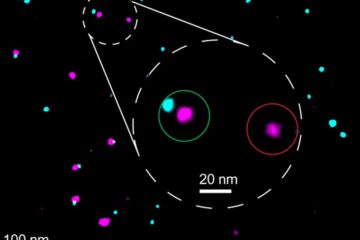Physics: Not everything is where it seems to be

The spiral wavefront of the elliptically polarized light hits the lens at a slight angle. IQOQI Innsbruck/Harald Ritsch
With modern optical imaging techniques, the position of objects can be measured with a precision that reaches a few nanometers. These techniques are used in the laboratory, for example, to determine the position of atoms in quantum experiments.
“We want to know the position of our quantum bits very precisely so that we can manipulate and measure them with laser beams,” explains Gabriel Araneda from the Department of Experimental Physics at the University of Innsbruck.
A collaborative work between physicists at TU Wien, Vienna, led by Arno Rauschenbeutel (now an Alexander von Humboldt Professor at Humboldt-Universität zu Berlin), and researchers at the University of Innsbruck and the Institute of Quantum Optics and Quantum Information, led by Rainer Blatt, has now demonstrated that a systematic error can occur when determining the position of particles that emit elliptically polarized light.
“The elliptical polarization causes the wavefronts of the light to have a spiral shape and to hit the imaging optics at a slight angle. This leads to the impression that the source of the light is somewhat off its actual position,” explains Yves Colombe from Rainer Blatt's team. This could be relevant, for example, in biomedical research, where luminous proteins or nanoparticles are used as markers to determine biological structures. The effect that has now been proven would possibly lead to a distorted image of the actual structures.
Any kind of waves could show this behavior
More than 80 years ago, the physicist Charles G. Darwin, grandson of the British natural scientist Charles Darwin, predicted this effect. Since that time, several theoretical studies have substantiated his prediction. Now, it has been possible for the first time to clearly prove the wave effect in experiments, and this twice:
At the University of Innsbruck, physicists determined, through single photon emission, the position of a single barium atom trapped in an ion trap. Physicists at Atominstitut of TU Wien (Vienna) determined the position of a small gold sphere, about 100 nanometers in size, by analyzing its scattered light. In both cases, there was a difference between the observed and the actual position of the particle.
“The deviation is on the order of the wavelength of the light and it can add up to a considerable measurement error in many applications,” says Stefan Walser from Arno Rauschenbeutel’s team. “Super-resolution light microscopy, for example, has already penetrated far into the nanometer range, whereas this effect can lead to errors of several 100 nanometers.”
The scientists believe it is very likely that this fundamental systematic error will also play a role in these applications, but this has yet to be proven in separate studies. The researchers also assume that this effect will not only be observed with light sources, but that radar or sonar measurements, for example, could also be affected. The effect could even play a role in future applications for the position estimation of astronomical objects using their gravitational waves emission.
The work has been published in Nature Physics and was financially supported by the Austrian Science Fund FWF, the European Union and the Tyrolean Federation of Industry.
Gabriel Araneda
Department of Experimental Physics
University of Innsbruck
phone: +43 512 507 52472
email: Gabriel.Araneda-Machuca@uibk.ac.at
web: https://quantumoptics.at
Stefan Walser
Atominstitut
TU Wien
phone: +43 1 58801 141723
email: stefan.walser@tuwien.ac.at
web: http://nanofiber.at
Wavelength-scale errors in optical localization due to spin-orbit coupling of light. G. Araneda, S. Walser, Y. Colombe, D. B. Higginbottom, J. Volz, R. Blatt, and A. Rauschenbeutel. Nature Physics 2018 DOI: https://doi.org/10.1038/s41567-018-0301-y
Media Contact
All latest news from the category: Physics and Astronomy
This area deals with the fundamental laws and building blocks of nature and how they interact, the properties and the behavior of matter, and research into space and time and their structures.
innovations-report provides in-depth reports and articles on subjects such as astrophysics, laser technologies, nuclear, quantum, particle and solid-state physics, nanotechnologies, planetary research and findings (Mars, Venus) and developments related to the Hubble Telescope.
Newest articles

High-energy-density aqueous battery based on halogen multi-electron transfer
Traditional non-aqueous lithium-ion batteries have a high energy density, but their safety is compromised due to the flammable organic electrolytes they utilize. Aqueous batteries use water as the solvent for…

First-ever combined heart pump and pig kidney transplant
…gives new hope to patient with terminal illness. Surgeons at NYU Langone Health performed the first-ever combined mechanical heart pump and gene-edited pig kidney transplant surgery in a 54-year-old woman…

Biophysics: Testing how well biomarkers work
LMU researchers have developed a method to determine how reliably target proteins can be labeled using super-resolution fluorescence microscopy. Modern microscopy techniques make it possible to examine the inner workings…





















